A Study on British Perception and Attitude Towards Indian Food
VerifiedAdded on 2020/10/22
|20
|4312
|468
Report
AI Summary
This research project investigates British attitudes towards Indian food, focusing on the perceptions and preferences of British individuals regarding Indian cuisine. The study aims to explore the challenges faced by Indian restaurants in the UK, such as changing tastes, competition, and economic factors like Brexit, and to recommend strategies for overcoming these obstacles. The methodology includes an inductive research approach and interpretivism philosophy, with data collection primarily through questionnaires. The literature review highlights the historical connections between India and the UK, the popularity of Indian food, and the evolving trends in the market. The findings and discussion section, based on questionnaire data, provide insights into consumer behavior and preferences. The report concludes with recommendations for Indian restaurants to adapt to the changing market and retain customers, including revamping dishes, implementing marketing strategies, and understanding consumer behavior. The significance of the research lies in its ability to help restaurants understand consumer demand and adapt to market changes.

RESEARCH PROJECT
Paraphrase This Document
Need a fresh take? Get an instant paraphrase of this document with our AI Paraphraser
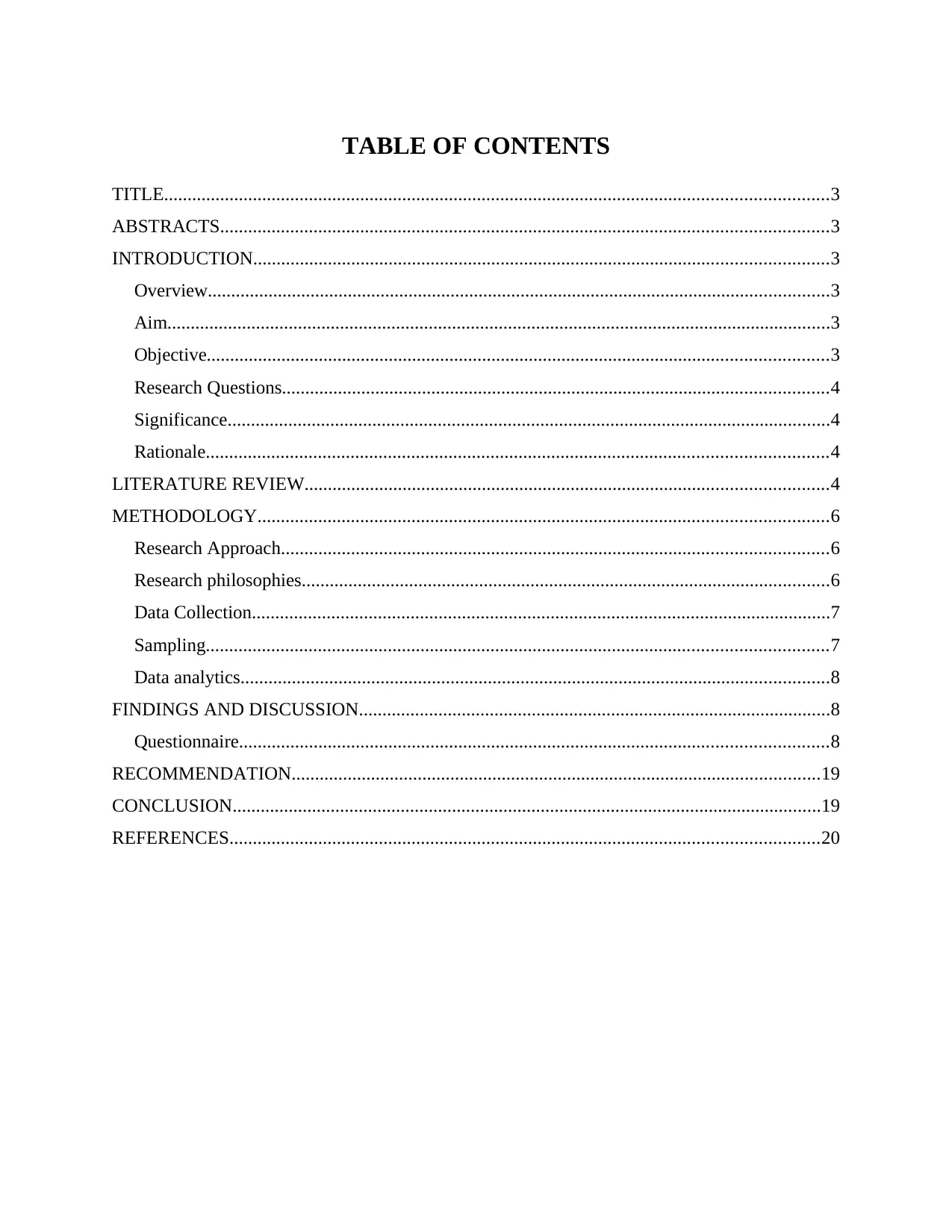
TABLE OF CONTENTS
TITLE..............................................................................................................................................3
ABSTRACTS..................................................................................................................................3
INTRODUCTION...........................................................................................................................3
Overview.....................................................................................................................................3
Aim..............................................................................................................................................3
Objective.....................................................................................................................................3
Research Questions.....................................................................................................................4
Significance.................................................................................................................................4
Rationale.....................................................................................................................................4
LITERATURE REVIEW................................................................................................................4
METHODOLOGY..........................................................................................................................6
Research Approach.....................................................................................................................6
Research philosophies.................................................................................................................6
Data Collection............................................................................................................................7
Sampling.....................................................................................................................................7
Data analytics..............................................................................................................................8
FINDINGS AND DISCUSSION.....................................................................................................8
Questionnaire..............................................................................................................................8
RECOMMENDATION.................................................................................................................19
CONCLUSION..............................................................................................................................19
REFERENCES..............................................................................................................................20
TITLE..............................................................................................................................................3
ABSTRACTS..................................................................................................................................3
INTRODUCTION...........................................................................................................................3
Overview.....................................................................................................................................3
Aim..............................................................................................................................................3
Objective.....................................................................................................................................3
Research Questions.....................................................................................................................4
Significance.................................................................................................................................4
Rationale.....................................................................................................................................4
LITERATURE REVIEW................................................................................................................4
METHODOLOGY..........................................................................................................................6
Research Approach.....................................................................................................................6
Research philosophies.................................................................................................................6
Data Collection............................................................................................................................7
Sampling.....................................................................................................................................7
Data analytics..............................................................................................................................8
FINDINGS AND DISCUSSION.....................................................................................................8
Questionnaire..............................................................................................................................8
RECOMMENDATION.................................................................................................................19
CONCLUSION..............................................................................................................................19
REFERENCES..............................................................................................................................20
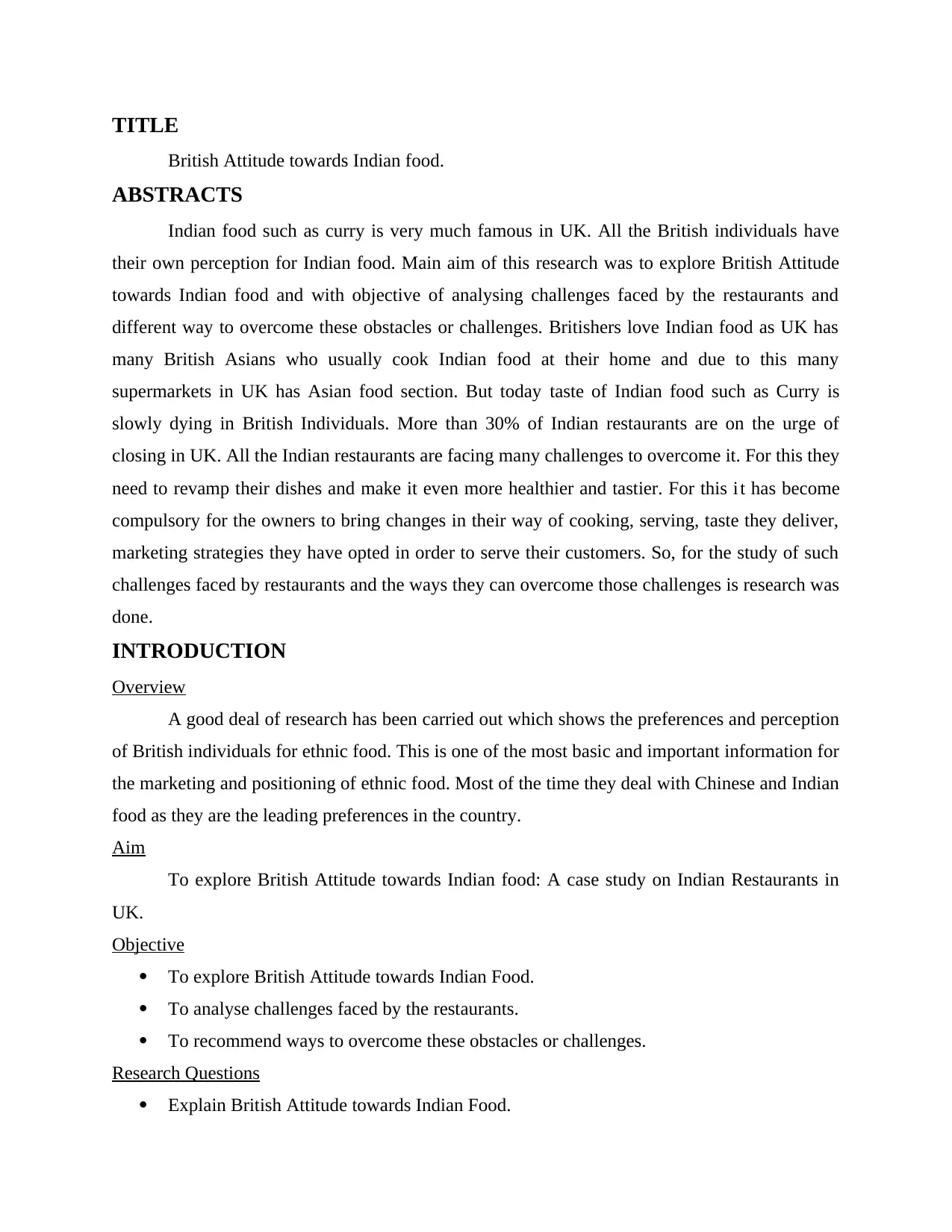
TITLE
British Attitude towards Indian food.
ABSTRACTS
Indian food such as curry is very much famous in UK. All the British individuals have
their own perception for Indian food. Main aim of this research was to explore British Attitude
towards Indian food and with objective of analysing challenges faced by the restaurants and
different way to overcome these obstacles or challenges. Britishers love Indian food as UK has
many British Asians who usually cook Indian food at their home and due to this many
supermarkets in UK has Asian food section. But today taste of Indian food such as Curry is
slowly dying in British Individuals. More than 30% of Indian restaurants are on the urge of
closing in UK. All the Indian restaurants are facing many challenges to overcome it. For this they
need to revamp their dishes and make it even more healthier and tastier. For this it has become
compulsory for the owners to bring changes in their way of cooking, serving, taste they deliver,
marketing strategies they have opted in order to serve their customers. So, for the study of such
challenges faced by restaurants and the ways they can overcome those challenges is research was
done.
INTRODUCTION
Overview
A good deal of research has been carried out which shows the preferences and perception
of British individuals for ethnic food. This is one of the most basic and important information for
the marketing and positioning of ethnic food. Most of the time they deal with Chinese and Indian
food as they are the leading preferences in the country.
Aim
To explore British Attitude towards Indian food: A case study on Indian Restaurants in
UK.
Objective
To explore British Attitude towards Indian Food.
To analyse challenges faced by the restaurants.
To recommend ways to overcome these obstacles or challenges.
Research Questions
Explain British Attitude towards Indian Food.
British Attitude towards Indian food.
ABSTRACTS
Indian food such as curry is very much famous in UK. All the British individuals have
their own perception for Indian food. Main aim of this research was to explore British Attitude
towards Indian food and with objective of analysing challenges faced by the restaurants and
different way to overcome these obstacles or challenges. Britishers love Indian food as UK has
many British Asians who usually cook Indian food at their home and due to this many
supermarkets in UK has Asian food section. But today taste of Indian food such as Curry is
slowly dying in British Individuals. More than 30% of Indian restaurants are on the urge of
closing in UK. All the Indian restaurants are facing many challenges to overcome it. For this they
need to revamp their dishes and make it even more healthier and tastier. For this it has become
compulsory for the owners to bring changes in their way of cooking, serving, taste they deliver,
marketing strategies they have opted in order to serve their customers. So, for the study of such
challenges faced by restaurants and the ways they can overcome those challenges is research was
done.
INTRODUCTION
Overview
A good deal of research has been carried out which shows the preferences and perception
of British individuals for ethnic food. This is one of the most basic and important information for
the marketing and positioning of ethnic food. Most of the time they deal with Chinese and Indian
food as they are the leading preferences in the country.
Aim
To explore British Attitude towards Indian food: A case study on Indian Restaurants in
UK.
Objective
To explore British Attitude towards Indian Food.
To analyse challenges faced by the restaurants.
To recommend ways to overcome these obstacles or challenges.
Research Questions
Explain British Attitude towards Indian Food.
⊘ This is a preview!⊘
Do you want full access?
Subscribe today to unlock all pages.

Trusted by 1+ million students worldwide
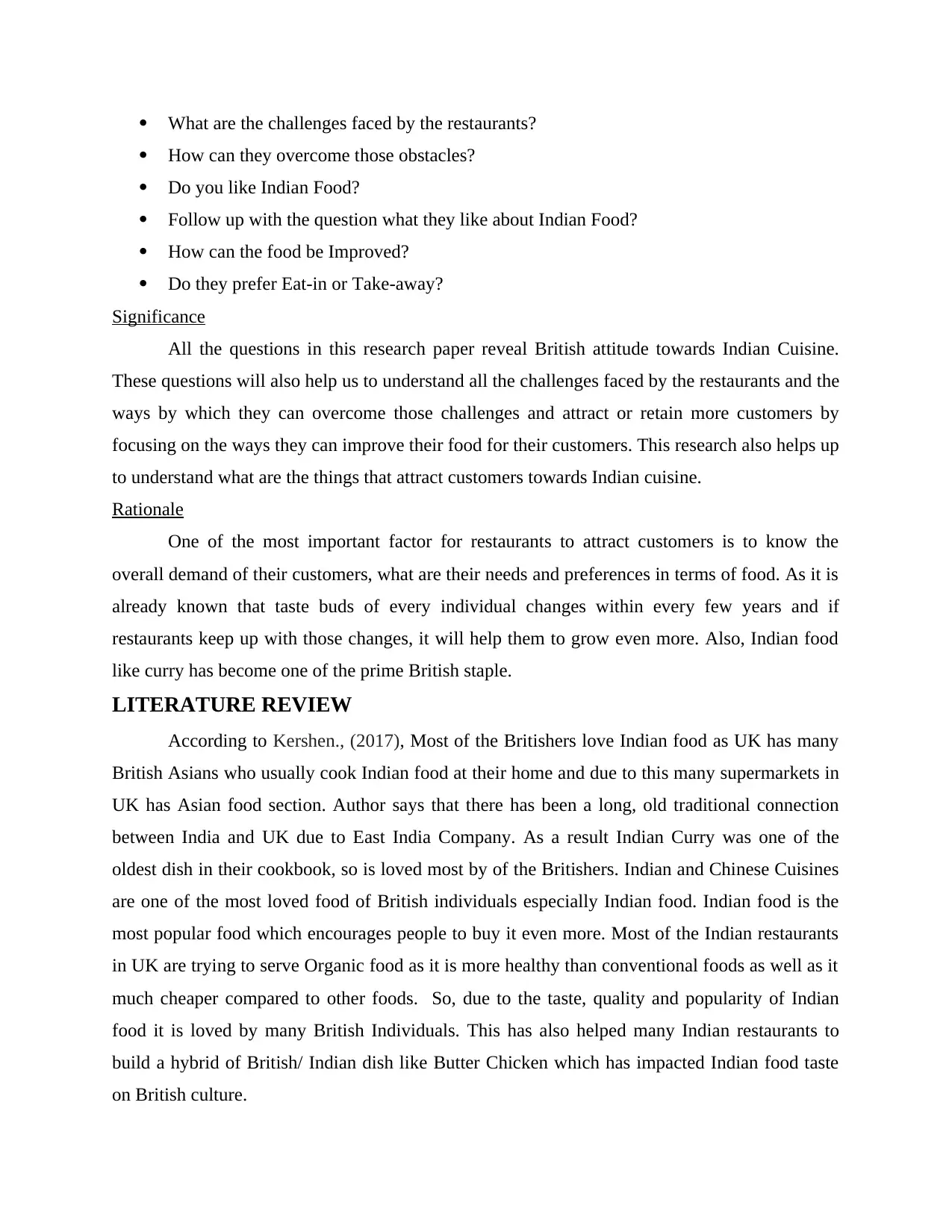
What are the challenges faced by the restaurants?
How can they overcome those obstacles?
Do you like Indian Food?
Follow up with the question what they like about Indian Food?
How can the food be Improved?
Do they prefer Eat-in or Take-away?
Significance
All the questions in this research paper reveal British attitude towards Indian Cuisine.
These questions will also help us to understand all the challenges faced by the restaurants and the
ways by which they can overcome those challenges and attract or retain more customers by
focusing on the ways they can improve their food for their customers. This research also helps up
to understand what are the things that attract customers towards Indian cuisine.
Rationale
One of the most important factor for restaurants to attract customers is to know the
overall demand of their customers, what are their needs and preferences in terms of food. As it is
already known that taste buds of every individual changes within every few years and if
restaurants keep up with those changes, it will help them to grow even more. Also, Indian food
like curry has become one of the prime British staple.
LITERATURE REVIEW
According to Kershen., (2017), Most of the Britishers love Indian food as UK has many
British Asians who usually cook Indian food at their home and due to this many supermarkets in
UK has Asian food section. Author says that there has been a long, old traditional connection
between India and UK due to East India Company. As a result Indian Curry was one of the
oldest dish in their cookbook, so is loved most by of the Britishers. Indian and Chinese Cuisines
are one of the most loved food of British individuals especially Indian food. Indian food is the
most popular food which encourages people to buy it even more. Most of the Indian restaurants
in UK are trying to serve Organic food as it is more healthy than conventional foods as well as it
much cheaper compared to other foods. So, due to the taste, quality and popularity of Indian
food it is loved by many British Individuals. This has also helped many Indian restaurants to
build a hybrid of British/ Indian dish like Butter Chicken which has impacted Indian food taste
on British culture.
How can they overcome those obstacles?
Do you like Indian Food?
Follow up with the question what they like about Indian Food?
How can the food be Improved?
Do they prefer Eat-in or Take-away?
Significance
All the questions in this research paper reveal British attitude towards Indian Cuisine.
These questions will also help us to understand all the challenges faced by the restaurants and the
ways by which they can overcome those challenges and attract or retain more customers by
focusing on the ways they can improve their food for their customers. This research also helps up
to understand what are the things that attract customers towards Indian cuisine.
Rationale
One of the most important factor for restaurants to attract customers is to know the
overall demand of their customers, what are their needs and preferences in terms of food. As it is
already known that taste buds of every individual changes within every few years and if
restaurants keep up with those changes, it will help them to grow even more. Also, Indian food
like curry has become one of the prime British staple.
LITERATURE REVIEW
According to Kershen., (2017), Most of the Britishers love Indian food as UK has many
British Asians who usually cook Indian food at their home and due to this many supermarkets in
UK has Asian food section. Author says that there has been a long, old traditional connection
between India and UK due to East India Company. As a result Indian Curry was one of the
oldest dish in their cookbook, so is loved most by of the Britishers. Indian and Chinese Cuisines
are one of the most loved food of British individuals especially Indian food. Indian food is the
most popular food which encourages people to buy it even more. Most of the Indian restaurants
in UK are trying to serve Organic food as it is more healthy than conventional foods as well as it
much cheaper compared to other foods. So, due to the taste, quality and popularity of Indian
food it is loved by many British Individuals. This has also helped many Indian restaurants to
build a hybrid of British/ Indian dish like Butter Chicken which has impacted Indian food taste
on British culture.
Paraphrase This Document
Need a fresh take? Get an instant paraphrase of this document with our AI Paraphraser
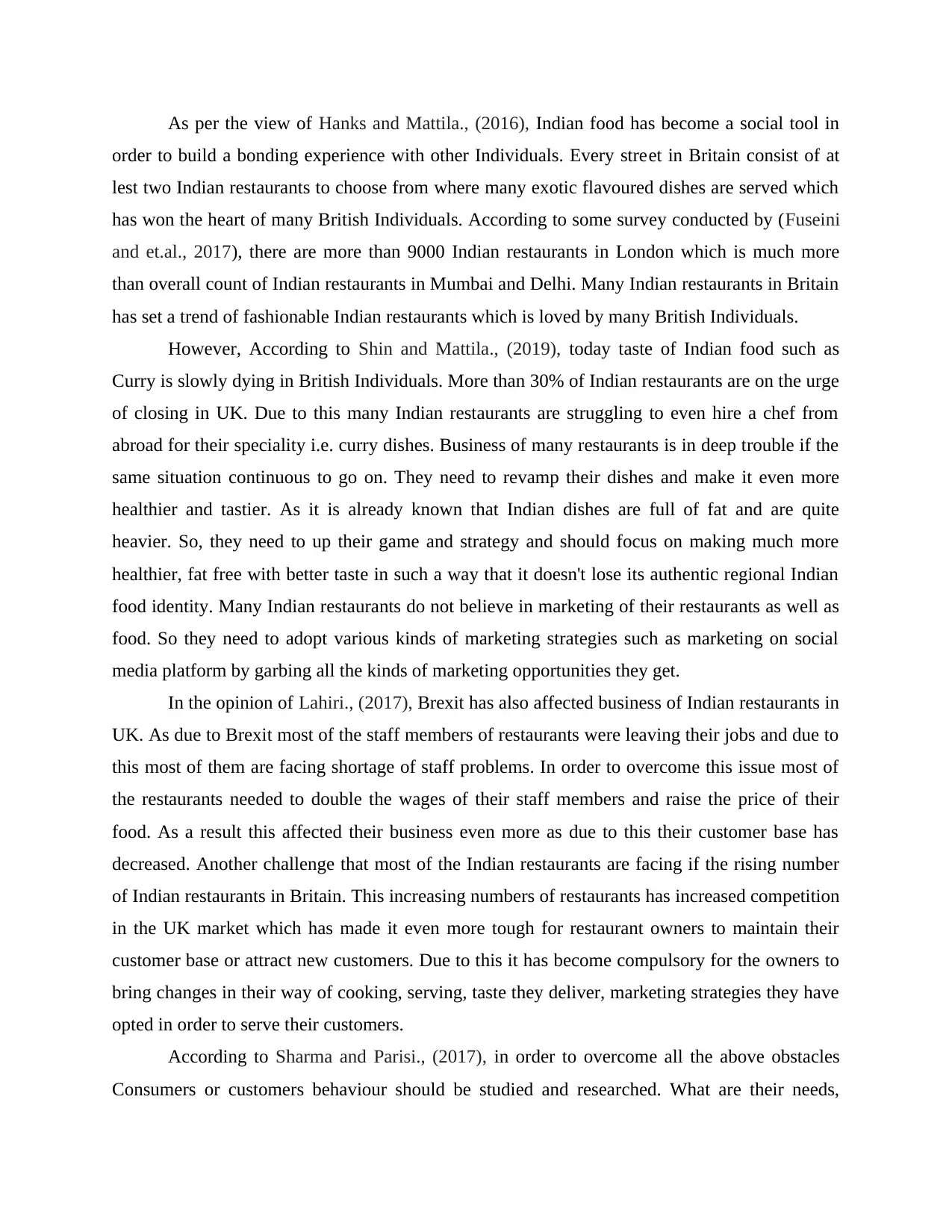
As per the view of Hanks and Mattila., (2016), Indian food has become a social tool in
order to build a bonding experience with other Individuals. Every street in Britain consist of at
lest two Indian restaurants to choose from where many exotic flavoured dishes are served which
has won the heart of many British Individuals. According to some survey conducted by (Fuseini
and et.al., 2017), there are more than 9000 Indian restaurants in London which is much more
than overall count of Indian restaurants in Mumbai and Delhi. Many Indian restaurants in Britain
has set a trend of fashionable Indian restaurants which is loved by many British Individuals.
However, According to Shin and Mattila., (2019), today taste of Indian food such as
Curry is slowly dying in British Individuals. More than 30% of Indian restaurants are on the urge
of closing in UK. Due to this many Indian restaurants are struggling to even hire a chef from
abroad for their speciality i.e. curry dishes. Business of many restaurants is in deep trouble if the
same situation continuous to go on. They need to revamp their dishes and make it even more
healthier and tastier. As it is already known that Indian dishes are full of fat and are quite
heavier. So, they need to up their game and strategy and should focus on making much more
healthier, fat free with better taste in such a way that it doesn't lose its authentic regional Indian
food identity. Many Indian restaurants do not believe in marketing of their restaurants as well as
food. So they need to adopt various kinds of marketing strategies such as marketing on social
media platform by garbing all the kinds of marketing opportunities they get.
In the opinion of Lahiri., (2017), Brexit has also affected business of Indian restaurants in
UK. As due to Brexit most of the staff members of restaurants were leaving their jobs and due to
this most of them are facing shortage of staff problems. In order to overcome this issue most of
the restaurants needed to double the wages of their staff members and raise the price of their
food. As a result this affected their business even more as due to this their customer base has
decreased. Another challenge that most of the Indian restaurants are facing if the rising number
of Indian restaurants in Britain. This increasing numbers of restaurants has increased competition
in the UK market which has made it even more tough for restaurant owners to maintain their
customer base or attract new customers. Due to this it has become compulsory for the owners to
bring changes in their way of cooking, serving, taste they deliver, marketing strategies they have
opted in order to serve their customers.
According to Sharma and Parisi., (2017), in order to overcome all the above obstacles
Consumers or customers behaviour should be studied and researched. What are their needs,
order to build a bonding experience with other Individuals. Every street in Britain consist of at
lest two Indian restaurants to choose from where many exotic flavoured dishes are served which
has won the heart of many British Individuals. According to some survey conducted by (Fuseini
and et.al., 2017), there are more than 9000 Indian restaurants in London which is much more
than overall count of Indian restaurants in Mumbai and Delhi. Many Indian restaurants in Britain
has set a trend of fashionable Indian restaurants which is loved by many British Individuals.
However, According to Shin and Mattila., (2019), today taste of Indian food such as
Curry is slowly dying in British Individuals. More than 30% of Indian restaurants are on the urge
of closing in UK. Due to this many Indian restaurants are struggling to even hire a chef from
abroad for their speciality i.e. curry dishes. Business of many restaurants is in deep trouble if the
same situation continuous to go on. They need to revamp their dishes and make it even more
healthier and tastier. As it is already known that Indian dishes are full of fat and are quite
heavier. So, they need to up their game and strategy and should focus on making much more
healthier, fat free with better taste in such a way that it doesn't lose its authentic regional Indian
food identity. Many Indian restaurants do not believe in marketing of their restaurants as well as
food. So they need to adopt various kinds of marketing strategies such as marketing on social
media platform by garbing all the kinds of marketing opportunities they get.
In the opinion of Lahiri., (2017), Brexit has also affected business of Indian restaurants in
UK. As due to Brexit most of the staff members of restaurants were leaving their jobs and due to
this most of them are facing shortage of staff problems. In order to overcome this issue most of
the restaurants needed to double the wages of their staff members and raise the price of their
food. As a result this affected their business even more as due to this their customer base has
decreased. Another challenge that most of the Indian restaurants are facing if the rising number
of Indian restaurants in Britain. This increasing numbers of restaurants has increased competition
in the UK market which has made it even more tough for restaurant owners to maintain their
customer base or attract new customers. Due to this it has become compulsory for the owners to
bring changes in their way of cooking, serving, taste they deliver, marketing strategies they have
opted in order to serve their customers.
According to Sharma and Parisi., (2017), in order to overcome all the above obstacles
Consumers or customers behaviour should be studied and researched. What are their needs,
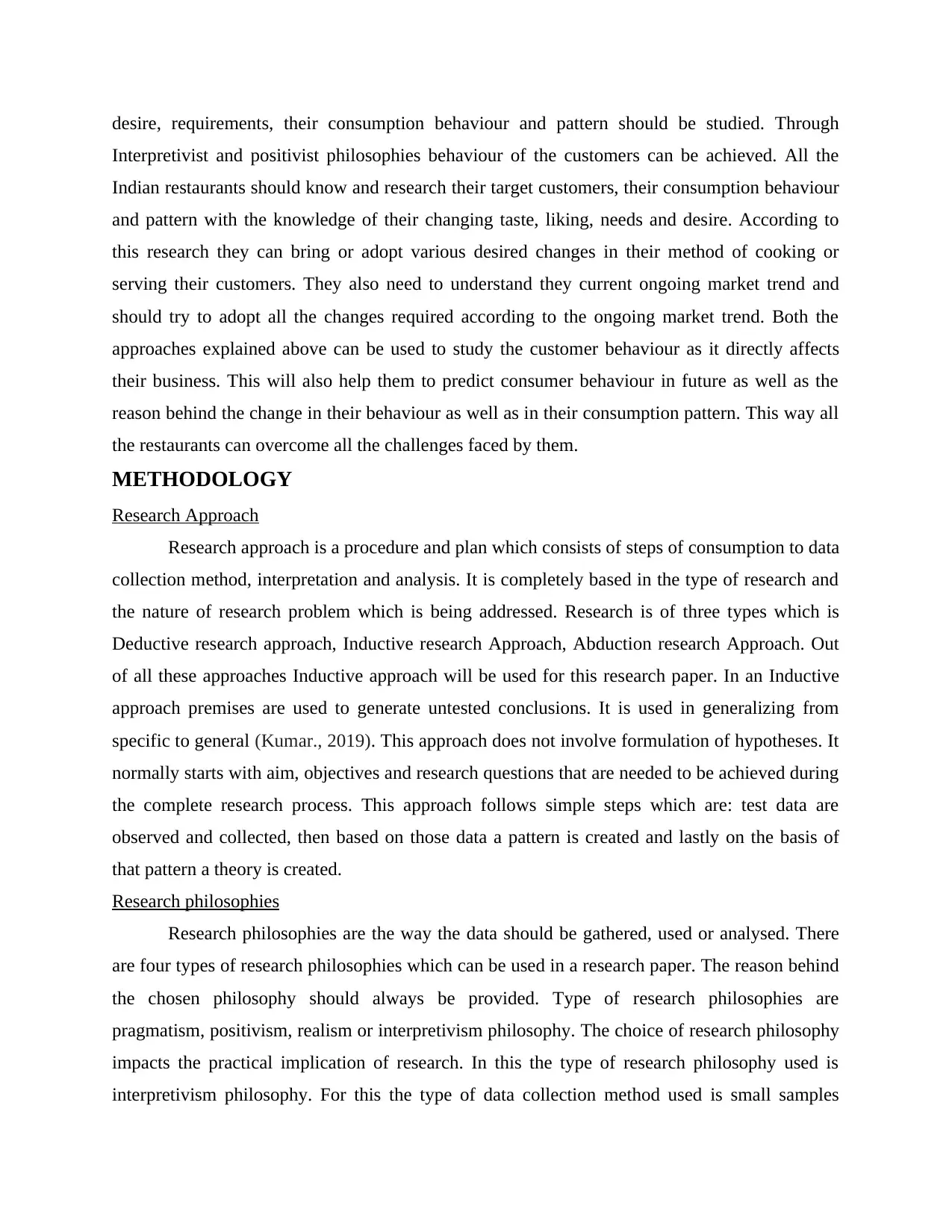
desire, requirements, their consumption behaviour and pattern should be studied. Through
Interpretivist and positivist philosophies behaviour of the customers can be achieved. All the
Indian restaurants should know and research their target customers, their consumption behaviour
and pattern with the knowledge of their changing taste, liking, needs and desire. According to
this research they can bring or adopt various desired changes in their method of cooking or
serving their customers. They also need to understand they current ongoing market trend and
should try to adopt all the changes required according to the ongoing market trend. Both the
approaches explained above can be used to study the customer behaviour as it directly affects
their business. This will also help them to predict consumer behaviour in future as well as the
reason behind the change in their behaviour as well as in their consumption pattern. This way all
the restaurants can overcome all the challenges faced by them.
METHODOLOGY
Research Approach
Research approach is a procedure and plan which consists of steps of consumption to data
collection method, interpretation and analysis. It is completely based in the type of research and
the nature of research problem which is being addressed. Research is of three types which is
Deductive research approach, Inductive research Approach, Abduction research Approach. Out
of all these approaches Inductive approach will be used for this research paper. In an Inductive
approach premises are used to generate untested conclusions. It is used in generalizing from
specific to general (Kumar., 2019). This approach does not involve formulation of hypotheses. It
normally starts with aim, objectives and research questions that are needed to be achieved during
the complete research process. This approach follows simple steps which are: test data are
observed and collected, then based on those data a pattern is created and lastly on the basis of
that pattern a theory is created.
Research philosophies
Research philosophies are the way the data should be gathered, used or analysed. There
are four types of research philosophies which can be used in a research paper. The reason behind
the chosen philosophy should always be provided. Type of research philosophies are
pragmatism, positivism, realism or interpretivism philosophy. The choice of research philosophy
impacts the practical implication of research. In this the type of research philosophy used is
interpretivism philosophy. For this the type of data collection method used is small samples
Interpretivist and positivist philosophies behaviour of the customers can be achieved. All the
Indian restaurants should know and research their target customers, their consumption behaviour
and pattern with the knowledge of their changing taste, liking, needs and desire. According to
this research they can bring or adopt various desired changes in their method of cooking or
serving their customers. They also need to understand they current ongoing market trend and
should try to adopt all the changes required according to the ongoing market trend. Both the
approaches explained above can be used to study the customer behaviour as it directly affects
their business. This will also help them to predict consumer behaviour in future as well as the
reason behind the change in their behaviour as well as in their consumption pattern. This way all
the restaurants can overcome all the challenges faced by them.
METHODOLOGY
Research Approach
Research approach is a procedure and plan which consists of steps of consumption to data
collection method, interpretation and analysis. It is completely based in the type of research and
the nature of research problem which is being addressed. Research is of three types which is
Deductive research approach, Inductive research Approach, Abduction research Approach. Out
of all these approaches Inductive approach will be used for this research paper. In an Inductive
approach premises are used to generate untested conclusions. It is used in generalizing from
specific to general (Kumar., 2019). This approach does not involve formulation of hypotheses. It
normally starts with aim, objectives and research questions that are needed to be achieved during
the complete research process. This approach follows simple steps which are: test data are
observed and collected, then based on those data a pattern is created and lastly on the basis of
that pattern a theory is created.
Research philosophies
Research philosophies are the way the data should be gathered, used or analysed. There
are four types of research philosophies which can be used in a research paper. The reason behind
the chosen philosophy should always be provided. Type of research philosophies are
pragmatism, positivism, realism or interpretivism philosophy. The choice of research philosophy
impacts the practical implication of research. In this the type of research philosophy used is
interpretivism philosophy. For this the type of data collection method used is small samples
⊘ This is a preview!⊘
Do you want full access?
Subscribe today to unlock all pages.

Trusted by 1+ million students worldwide
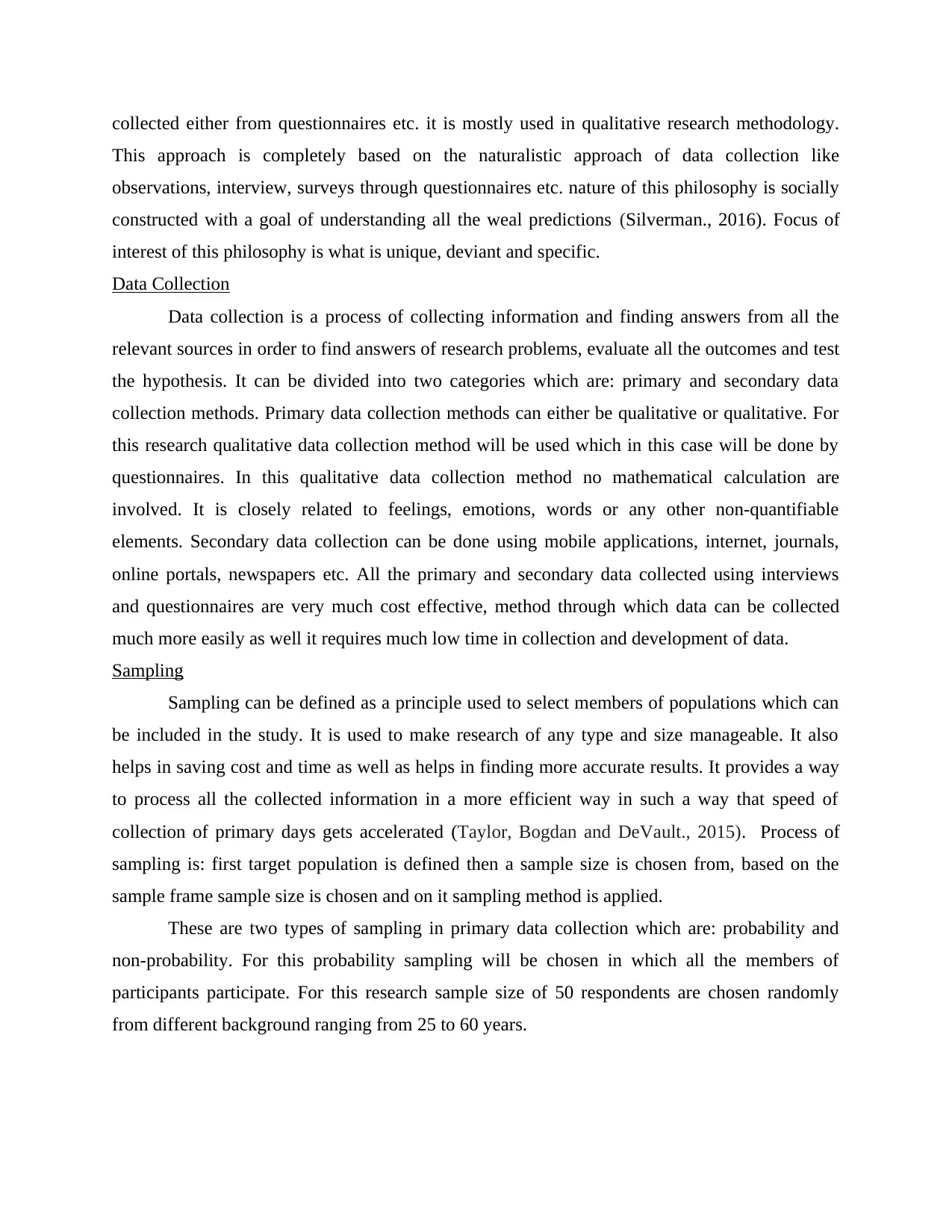
collected either from questionnaires etc. it is mostly used in qualitative research methodology.
This approach is completely based on the naturalistic approach of data collection like
observations, interview, surveys through questionnaires etc. nature of this philosophy is socially
constructed with a goal of understanding all the weal predictions (Silverman., 2016). Focus of
interest of this philosophy is what is unique, deviant and specific.
Data Collection
Data collection is a process of collecting information and finding answers from all the
relevant sources in order to find answers of research problems, evaluate all the outcomes and test
the hypothesis. It can be divided into two categories which are: primary and secondary data
collection methods. Primary data collection methods can either be qualitative or qualitative. For
this research qualitative data collection method will be used which in this case will be done by
questionnaires. In this qualitative data collection method no mathematical calculation are
involved. It is closely related to feelings, emotions, words or any other non-quantifiable
elements. Secondary data collection can be done using mobile applications, internet, journals,
online portals, newspapers etc. All the primary and secondary data collected using interviews
and questionnaires are very much cost effective, method through which data can be collected
much more easily as well it requires much low time in collection and development of data.
Sampling
Sampling can be defined as a principle used to select members of populations which can
be included in the study. It is used to make research of any type and size manageable. It also
helps in saving cost and time as well as helps in finding more accurate results. It provides a way
to process all the collected information in a more efficient way in such a way that speed of
collection of primary days gets accelerated (Taylor, Bogdan and DeVault., 2015). Process of
sampling is: first target population is defined then a sample size is chosen from, based on the
sample frame sample size is chosen and on it sampling method is applied.
These are two types of sampling in primary data collection which are: probability and
non-probability. For this probability sampling will be chosen in which all the members of
participants participate. For this research sample size of 50 respondents are chosen randomly
from different background ranging from 25 to 60 years.
This approach is completely based on the naturalistic approach of data collection like
observations, interview, surveys through questionnaires etc. nature of this philosophy is socially
constructed with a goal of understanding all the weal predictions (Silverman., 2016). Focus of
interest of this philosophy is what is unique, deviant and specific.
Data Collection
Data collection is a process of collecting information and finding answers from all the
relevant sources in order to find answers of research problems, evaluate all the outcomes and test
the hypothesis. It can be divided into two categories which are: primary and secondary data
collection methods. Primary data collection methods can either be qualitative or qualitative. For
this research qualitative data collection method will be used which in this case will be done by
questionnaires. In this qualitative data collection method no mathematical calculation are
involved. It is closely related to feelings, emotions, words or any other non-quantifiable
elements. Secondary data collection can be done using mobile applications, internet, journals,
online portals, newspapers etc. All the primary and secondary data collected using interviews
and questionnaires are very much cost effective, method through which data can be collected
much more easily as well it requires much low time in collection and development of data.
Sampling
Sampling can be defined as a principle used to select members of populations which can
be included in the study. It is used to make research of any type and size manageable. It also
helps in saving cost and time as well as helps in finding more accurate results. It provides a way
to process all the collected information in a more efficient way in such a way that speed of
collection of primary days gets accelerated (Taylor, Bogdan and DeVault., 2015). Process of
sampling is: first target population is defined then a sample size is chosen from, based on the
sample frame sample size is chosen and on it sampling method is applied.
These are two types of sampling in primary data collection which are: probability and
non-probability. For this probability sampling will be chosen in which all the members of
participants participate. For this research sample size of 50 respondents are chosen randomly
from different background ranging from 25 to 60 years.
Paraphrase This Document
Need a fresh take? Get an instant paraphrase of this document with our AI Paraphraser
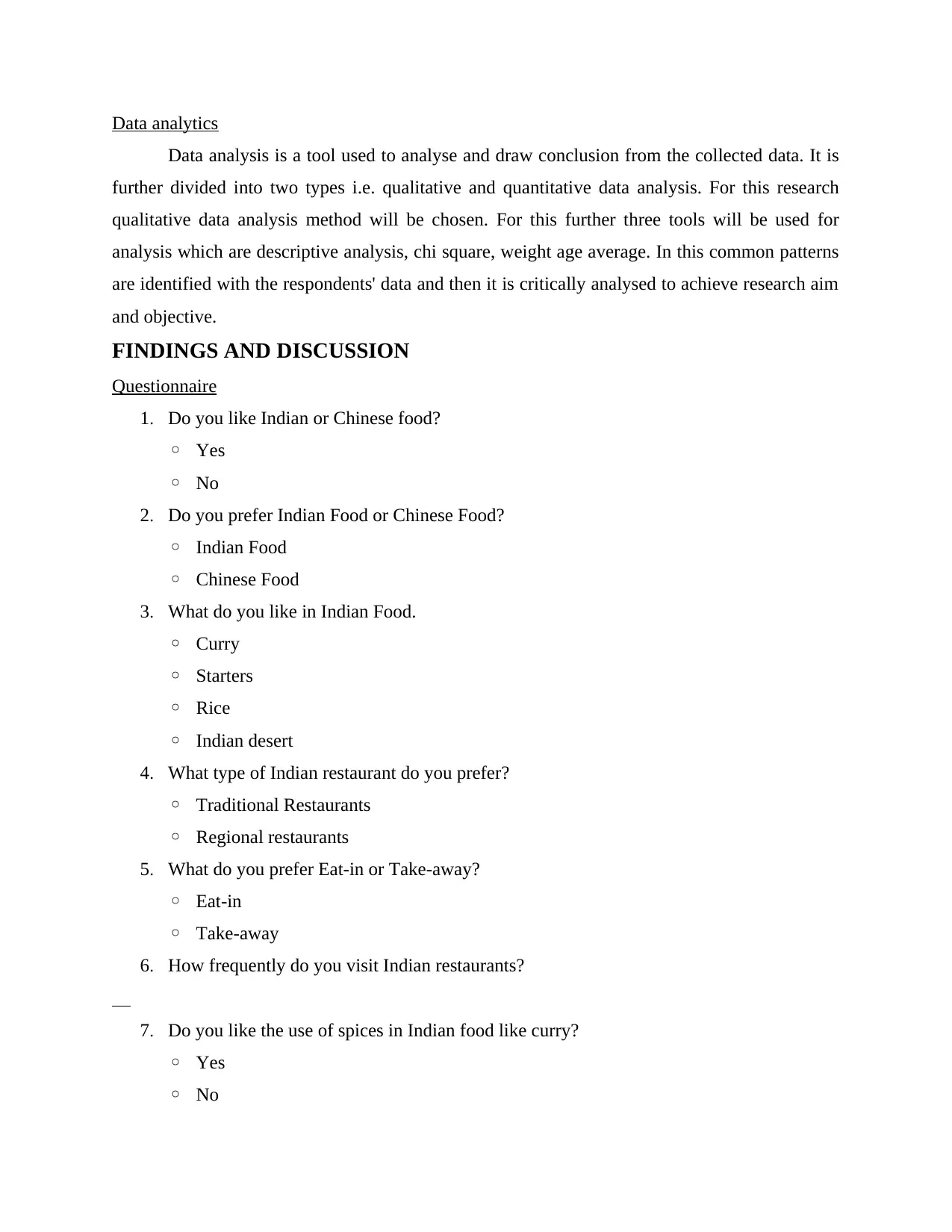
Data analytics
Data analysis is a tool used to analyse and draw conclusion from the collected data. It is
further divided into two types i.e. qualitative and quantitative data analysis. For this research
qualitative data analysis method will be chosen. For this further three tools will be used for
analysis which are descriptive analysis, chi square, weight age average. In this common patterns
are identified with the respondents' data and then it is critically analysed to achieve research aim
and objective.
FINDINGS AND DISCUSSION
Questionnaire
1. Do you like Indian or Chinese food?
◦ Yes
◦ No
2. Do you prefer Indian Food or Chinese Food?
◦ Indian Food
◦ Chinese Food
3. What do you like in Indian Food.
◦ Curry
◦ Starters
◦ Rice
◦ Indian desert
4. What type of Indian restaurant do you prefer?
◦ Traditional Restaurants
◦ Regional restaurants
5. What do you prefer Eat-in or Take-away?
◦ Eat-in
◦ Take-away
6. How frequently do you visit Indian restaurants?
7. Do you like the use of spices in Indian food like curry?
◦ Yes
◦ No
Data analysis is a tool used to analyse and draw conclusion from the collected data. It is
further divided into two types i.e. qualitative and quantitative data analysis. For this research
qualitative data analysis method will be chosen. For this further three tools will be used for
analysis which are descriptive analysis, chi square, weight age average. In this common patterns
are identified with the respondents' data and then it is critically analysed to achieve research aim
and objective.
FINDINGS AND DISCUSSION
Questionnaire
1. Do you like Indian or Chinese food?
◦ Yes
◦ No
2. Do you prefer Indian Food or Chinese Food?
◦ Indian Food
◦ Chinese Food
3. What do you like in Indian Food.
◦ Curry
◦ Starters
◦ Rice
◦ Indian desert
4. What type of Indian restaurant do you prefer?
◦ Traditional Restaurants
◦ Regional restaurants
5. What do you prefer Eat-in or Take-away?
◦ Eat-in
◦ Take-away
6. How frequently do you visit Indian restaurants?
7. Do you like the use of spices in Indian food like curry?
◦ Yes
◦ No
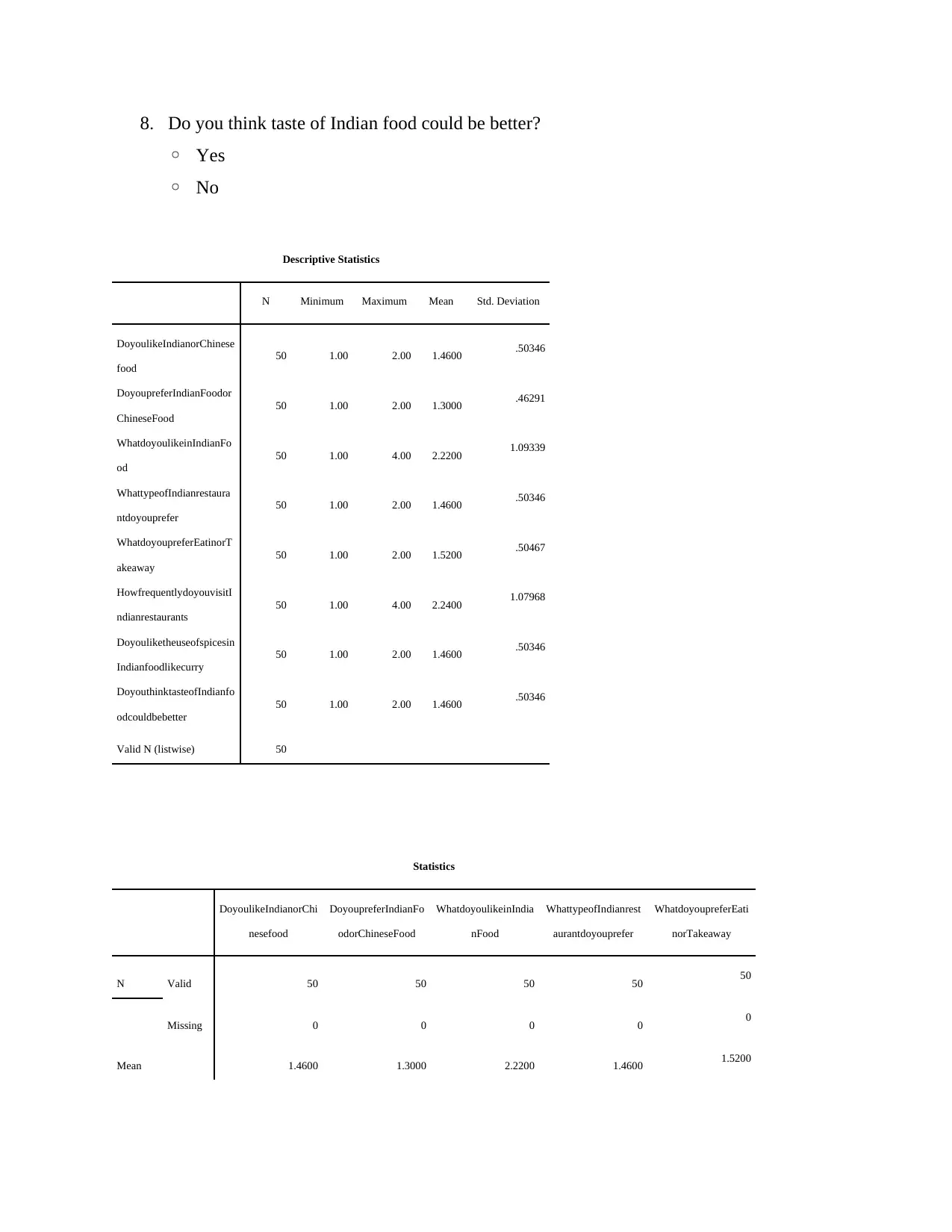
8. Do you think taste of Indian food could be better?
◦ Yes
◦ No
Descriptive Statistics
N Minimum Maximum Mean Std. Deviation
DoyoulikeIndianorChinese
food
50 1.00 2.00 1.4600 .50346
DoyoupreferIndianFoodor
ChineseFood
50 1.00 2.00 1.3000 .46291
WhatdoyoulikeinIndianFo
od
50 1.00 4.00 2.2200 1.09339
WhattypeofIndianrestaura
ntdoyouprefer
50 1.00 2.00 1.4600 .50346
WhatdoyoupreferEatinorT
akeaway
50 1.00 2.00 1.5200 .50467
HowfrequentlydoyouvisitI
ndianrestaurants
50 1.00 4.00 2.2400 1.07968
Doyouliketheuseofspicesin
Indianfoodlikecurry
50 1.00 2.00 1.4600 .50346
DoyouthinktasteofIndianfo
odcouldbebetter
50 1.00 2.00 1.4600 .50346
Valid N (listwise) 50
Statistics
DoyoulikeIndianorChi
nesefood
DoyoupreferIndianFo
odorChineseFood
WhatdoyoulikeinIndia
nFood
WhattypeofIndianrest
aurantdoyouprefer
WhatdoyoupreferEati
norTakeaway
N Valid 50 50 50 50 50
Missing 0 0 0 0 0
Mean 1.4600 1.3000 2.2200 1.4600 1.5200
◦ Yes
◦ No
Descriptive Statistics
N Minimum Maximum Mean Std. Deviation
DoyoulikeIndianorChinese
food
50 1.00 2.00 1.4600 .50346
DoyoupreferIndianFoodor
ChineseFood
50 1.00 2.00 1.3000 .46291
WhatdoyoulikeinIndianFo
od
50 1.00 4.00 2.2200 1.09339
WhattypeofIndianrestaura
ntdoyouprefer
50 1.00 2.00 1.4600 .50346
WhatdoyoupreferEatinorT
akeaway
50 1.00 2.00 1.5200 .50467
HowfrequentlydoyouvisitI
ndianrestaurants
50 1.00 4.00 2.2400 1.07968
Doyouliketheuseofspicesin
Indianfoodlikecurry
50 1.00 2.00 1.4600 .50346
DoyouthinktasteofIndianfo
odcouldbebetter
50 1.00 2.00 1.4600 .50346
Valid N (listwise) 50
Statistics
DoyoulikeIndianorChi
nesefood
DoyoupreferIndianFo
odorChineseFood
WhatdoyoulikeinIndia
nFood
WhattypeofIndianrest
aurantdoyouprefer
WhatdoyoupreferEati
norTakeaway
N Valid 50 50 50 50 50
Missing 0 0 0 0 0
Mean 1.4600 1.3000 2.2200 1.4600 1.5200
⊘ This is a preview!⊘
Do you want full access?
Subscribe today to unlock all pages.

Trusted by 1+ million students worldwide
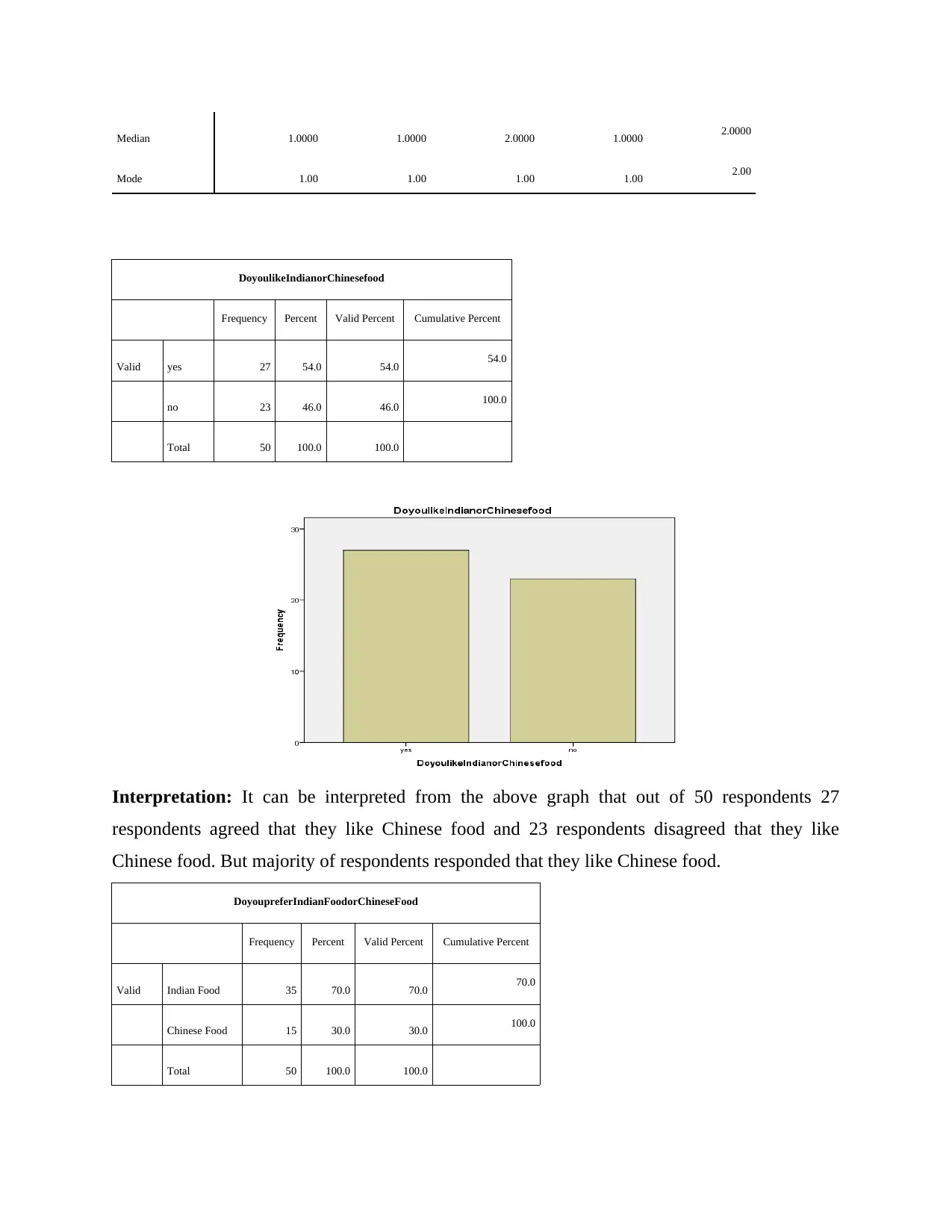
Median 1.0000 1.0000 2.0000 1.0000 2.0000
Mode 1.00 1.00 1.00 1.00 2.00
DoyoulikeIndianorChinesefood
Frequency Percent Valid Percent Cumulative Percent
Valid yes 27 54.0 54.0 54.0
no 23 46.0 46.0 100.0
Total 50 100.0 100.0
Interpretation: It can be interpreted from the above graph that out of 50 respondents 27
respondents agreed that they like Chinese food and 23 respondents disagreed that they like
Chinese food. But majority of respondents responded that they like Chinese food.
DoyoupreferIndianFoodorChineseFood
Frequency Percent Valid Percent Cumulative Percent
Valid Indian Food 35 70.0 70.0 70.0
Chinese Food 15 30.0 30.0 100.0
Total 50 100.0 100.0
Mode 1.00 1.00 1.00 1.00 2.00
DoyoulikeIndianorChinesefood
Frequency Percent Valid Percent Cumulative Percent
Valid yes 27 54.0 54.0 54.0
no 23 46.0 46.0 100.0
Total 50 100.0 100.0
Interpretation: It can be interpreted from the above graph that out of 50 respondents 27
respondents agreed that they like Chinese food and 23 respondents disagreed that they like
Chinese food. But majority of respondents responded that they like Chinese food.
DoyoupreferIndianFoodorChineseFood
Frequency Percent Valid Percent Cumulative Percent
Valid Indian Food 35 70.0 70.0 70.0
Chinese Food 15 30.0 30.0 100.0
Total 50 100.0 100.0
Paraphrase This Document
Need a fresh take? Get an instant paraphrase of this document with our AI Paraphraser
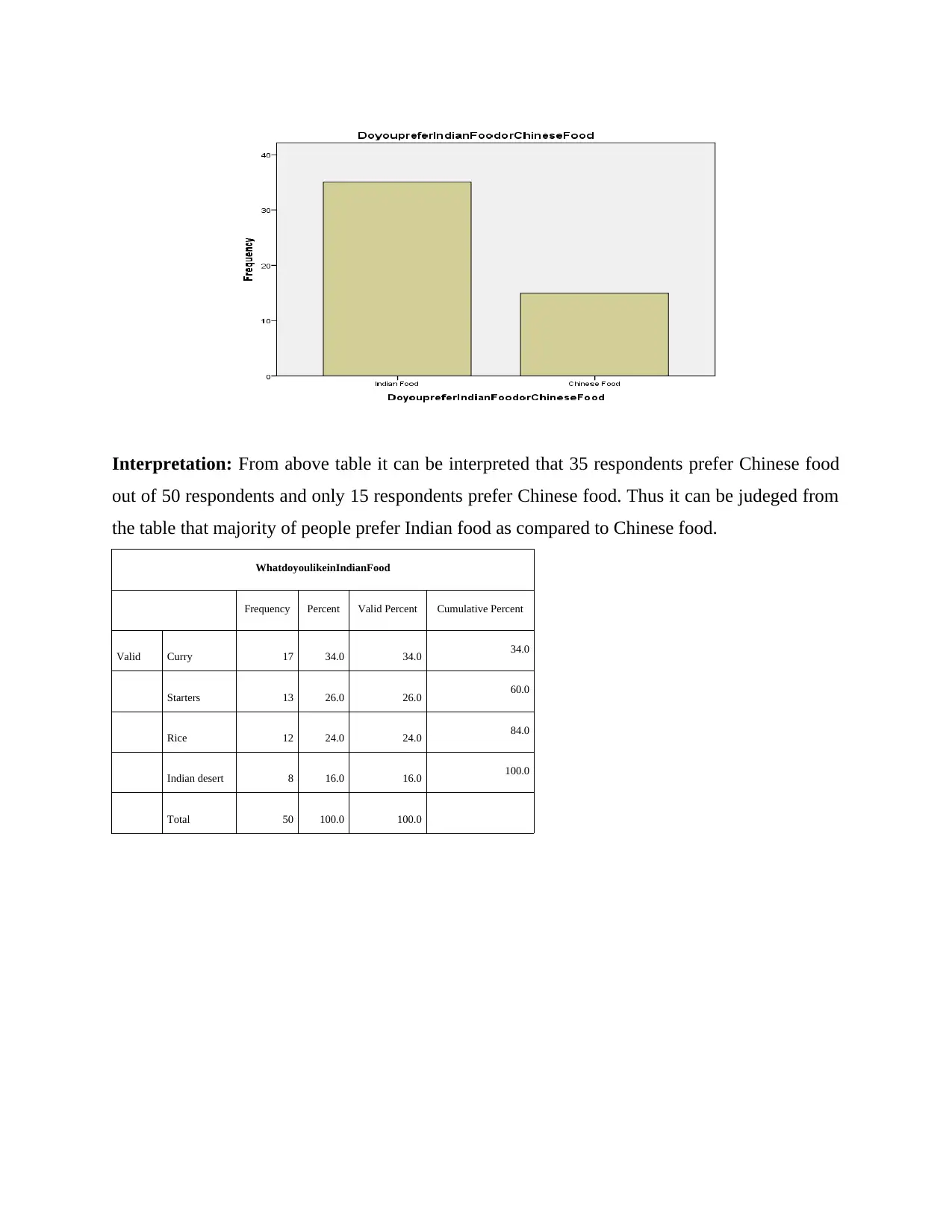
Interpretation: From above table it can be interpreted that 35 respondents prefer Chinese food
out of 50 respondents and only 15 respondents prefer Chinese food. Thus it can be judeged from
the table that majority of people prefer Indian food as compared to Chinese food.
WhatdoyoulikeinIndianFood
Frequency Percent Valid Percent Cumulative Percent
Valid Curry 17 34.0 34.0 34.0
Starters 13 26.0 26.0 60.0
Rice 12 24.0 24.0 84.0
Indian desert 8 16.0 16.0 100.0
Total 50 100.0 100.0
out of 50 respondents and only 15 respondents prefer Chinese food. Thus it can be judeged from
the table that majority of people prefer Indian food as compared to Chinese food.
WhatdoyoulikeinIndianFood
Frequency Percent Valid Percent Cumulative Percent
Valid Curry 17 34.0 34.0 34.0
Starters 13 26.0 26.0 60.0
Rice 12 24.0 24.0 84.0
Indian desert 8 16.0 16.0 100.0
Total 50 100.0 100.0
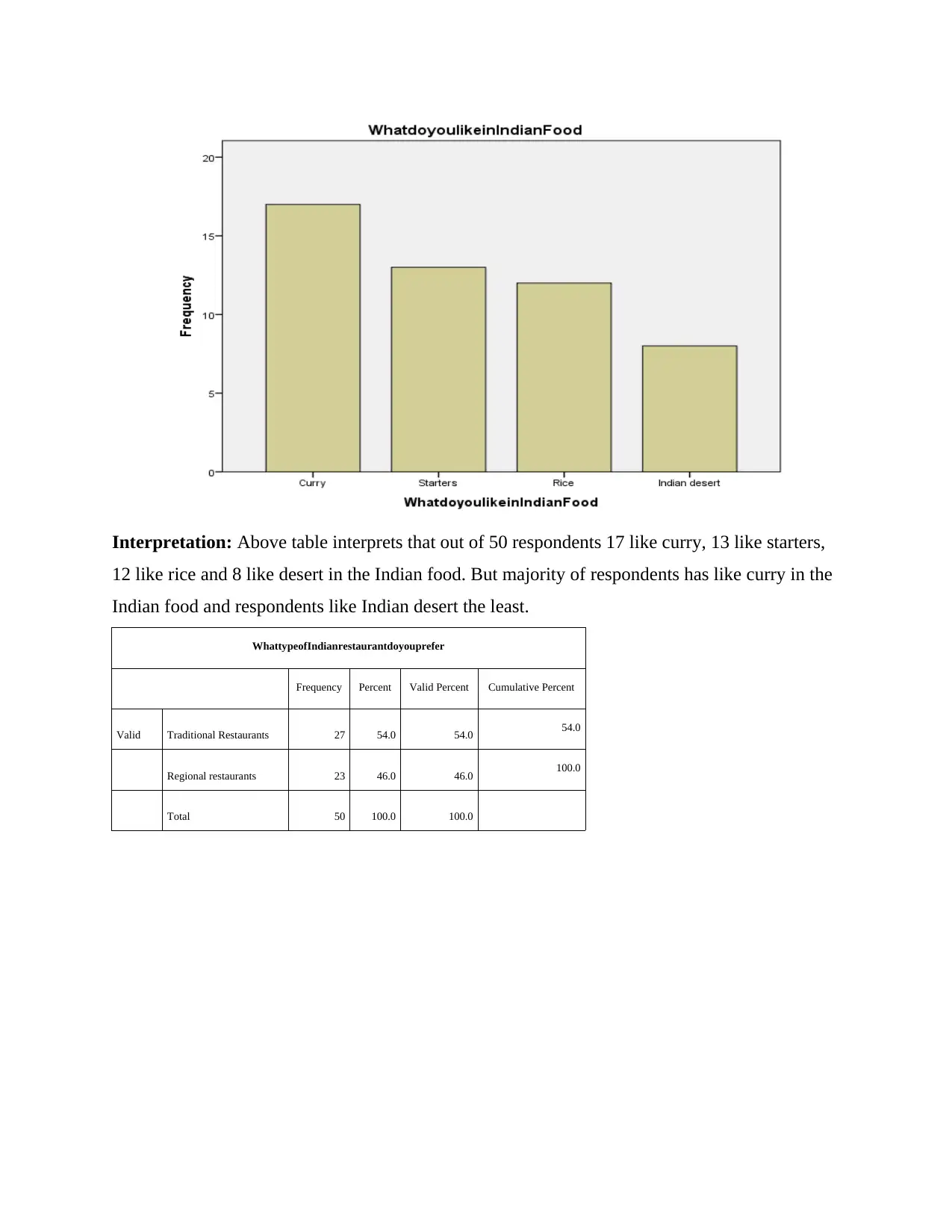
Interpretation: Above table interprets that out of 50 respondents 17 like curry, 13 like starters,
12 like rice and 8 like desert in the Indian food. But majority of respondents has like curry in the
Indian food and respondents like Indian desert the least.
WhattypeofIndianrestaurantdoyouprefer
Frequency Percent Valid Percent Cumulative Percent
Valid Traditional Restaurants 27 54.0 54.0 54.0
Regional restaurants 23 46.0 46.0 100.0
Total 50 100.0 100.0
12 like rice and 8 like desert in the Indian food. But majority of respondents has like curry in the
Indian food and respondents like Indian desert the least.
WhattypeofIndianrestaurantdoyouprefer
Frequency Percent Valid Percent Cumulative Percent
Valid Traditional Restaurants 27 54.0 54.0 54.0
Regional restaurants 23 46.0 46.0 100.0
Total 50 100.0 100.0
⊘ This is a preview!⊘
Do you want full access?
Subscribe today to unlock all pages.

Trusted by 1+ million students worldwide
1 out of 20
Related Documents
Your All-in-One AI-Powered Toolkit for Academic Success.
+13062052269
info@desklib.com
Available 24*7 on WhatsApp / Email
![[object Object]](/_next/static/media/star-bottom.7253800d.svg)
Unlock your academic potential
Copyright © 2020–2025 A2Z Services. All Rights Reserved. Developed and managed by ZUCOL.





